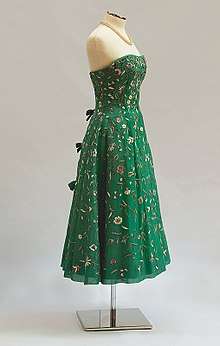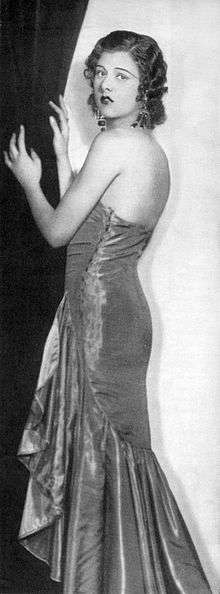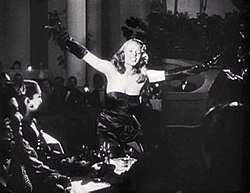Strapless dress
A strapless dress or top is a garment that stays put around the upper body without shoulder straps or other visible means of support. It is usually supported by an internal corset and/or brassiere, with the tightness of the bodice preventing the dress from slipping out of position.[1]

History

1930s to 1980s
According to Richard Martin and Harold Koda, the modern strapless dress first appeared in the 1930s, where it was popularised by designers such as Mainbocher, and, from the late 1940s, Christian Dior.[1] The July 18, 1938, issue of Life claimed that the "absolutely strapless, sleeveless evening dress" was a 1937–38 invention.[2] However, that was predated in 1930 by the actress Libby Holman, who had been photographed in an apparently strapless dress that year.[3] Holman became associated with the strapless dress and is regularly credited with inventing it,[4][5][6] or at least being one of its first high-profile wearers.[7]
In 1934, Mainbocher produced his first strapless gown, a black satin design which has been described as the first strapless evening dress.[8] Along with Holman and Mainbocher, the heiress Brenda Frazier is also credited with popularising the style when she wore a strapless débutante dress for her debut and famously appeared in it on the November 14, 1938, cover of Life.[9][10][11]

Strapless dresses remained popular after the Second World War, with the style sometimes being described as the "naked look".[12] One of the most famous strapless dresses of this period was the black satin gown worn by Rita Hayworth for a song and dance routine in Gilda.[13] Hayworth's performance demonstrated to viewers that strapless dresses could be secure enough to move around and dance in without risk of indecent exposure.[13] Despite this, more conservative customers might add shoulder straps to their new strapless dresses.[12] The style was also problematic for those who objected to its perceived immodesty. During the 1940s and 1950s, Catholic campaigners in the United States protested against "immodest" clothing, including two-piece and strapless swimsuits and dresses.[14] In 1954, the United States Army tried to ban Army wives and daughters in Germany from wearing shorts, jeans, and strapless dresses, "except at appropriate social functions."[15]
During the 1950s, notable strapless dress designers included Madame Grès, whose flowing Grecian dresses were mounted upon custom-designed interior corsets by Alice Cadolle.[16]
In the 1970s, Halston designed an unstructured strapless dress.[17] The knitted tube top was worn as a casual strapless option,[18] and by the 1980s, strapless dresses were made in stretchy, elastic fabrics which did not require boning or interior structure.[19]
1990s onwards
In 2012, the strapless dress was described as the most widely requested style for Western wedding dresses.[20] Vera Wang is sometimes credited with introducing this style of bridal dress in the first decade of the 21st century,[20] although strapless dresses were an increasingly valid option from the 1990s onwards with the growing popularity of formal civil weddings from the 1990s.[21][22] However, for religious weddings, strapless and shoulder-baring styles are potentially controversial,[21] and despite the popularity of the strapless wedding dress it is considered by some to be a "rejection of the virginal ideal".[23]
The strapless dress is also a very popular style for red carpet fashion.[13]
Social and cultural context
Since their introduction, strapless garments have proved problematic in many contexts. In the early 21st century, many schools and workplaces specifically forbid strapless garments as part of their dress code. An Adecco survey published in The Wall Street Journal in 2012 indicated that 72% of Americans thought strapless tops were inappropriate office wear.[24]
Religious stances
Strapless garments may be singled out for particular censure by preachers and clerics. In 2005, a Muslim cleric declared strapless garments "satanic", along with other revealing garments such as miniskirts and see-through clothing.[25] Spencer W. Kimball, the 12th President of The Church of Jesus Christ of Latter-day Saints (LDS church), declared that strapless gowns were neither righteous nor approved, and that no Latter-day Saint woman should wear one at any time,[26] whilst another Latter-day Saints declared them an "abomination in the sight of the Lord".[27] Such views may not necessarily reflect those of the majority of their associated religion, although a rule of thumb is that strapless garments are only acceptable in religious contexts, such as Catholic churches or Jewish bat mitzvahs, if the shoulders and arms are covered.[28][29]
References
- Martin, Richard; Koda, Harold (1996). Bare witness. New York: Metropolitan Museum of Art. p. 6. ISBN 9780870998027.
- "Underthings for the Strapless Vogue". LIFE: 33. 18 July 1938. Retrieved 18 March 2013.
- "The Lure of Libby Holman". Theatre Magazine. May 1930. p. 57. Retrieved 2016-09-29.
- Scheper, Jeanne. "Libby Holman." Jewish Women: A Comprehensive Historical Encyclopedia. 1 March 2009. Jewish Women's Archive. (Viewed on March 25, 2013).
- Casstevens, Frances H. (2006). Death in North Carolina's Piedmont : tales of murder, suicide and causes unknown. Charleston, SC: History Press. p. 74. ISBN 9781596291966.
- Bowie, Angie (2002). Bisexuality. Harpenden , Herts: Pocket Essentials. p. 58. ISBN 9781903047910.
Libby Holman was a Jewish American who invented the strapless gown and was a celebrated torch singer.
- Waggoner, Susan (2001). Nightclub nights : art, legend and style, 1920-1960. New York: Rizzoli. p. 18. ISBN 9780847823314.
Then there was the scandalous Libby Holman, whose accomplishments ranged from challenging race and gender stereotypes to popularizing the strapless evening gown.
- Steele, edited by Valerie (2010). The Berg companion to fashion. Oxford: Berg. p. 492. ISBN 9781847885920.CS1 maint: extra text: authors list (link)
- Gourley, Catherine (2008). Rosie and Mrs. America : perceptions of women in the 1930s and 1940s. Minneapolis, MN: Twenty-First Century Books. ISBN 9780822568049.
- Ketchum, Richard M. (1989). The borrowed years, 1938-1941 : America on the way to war (1st ed.). New York: Random House. ISBN 9780394560113.
strapless.
- "The Glamour Girl Reached her Peak". LIFE. 25 November 1946. Retrieved 18 March 2013.
- Palmer, Alexandra (2001). Couture & commerce : the transatlantic fashion trade in the 1950s. Vancouver: UBC Press [u.a.] p. 154. ISBN 9780774808262.
- Rubenstein, Hal (2012). 100 unforgettable dresses. New York: Harper Design. pp. 206–207. ISBN 9780062198884.
- Jay, Kathryn; Winston, Diane (2002). John M. Giggie (ed.). "In Vogue with Mary" - How Catholic Girls Created an Urban Market for Modesty; published in Faith in the market : religion and the rise of urban commercial culture. New Brunswick, N.J.: Rutgers University Press. pp. 177–198. ISBN 9780813530994.
- "Wives Told to Dress in Good Taste". The Age. 6 August 1954. Retrieved 18 March 2013.
- Polan, Brenda; Tredre, Roger (2009). The Great Fashion Designers (English ed.). Oxford: Berg. pp. 69. ISBN 9781847882271.
- Polan, Brenda; Tredre, Roger (2009). The Great Fashion Designers (English ed.). Oxford: Berg. pp. 139. ISBN 9781847882271.
- Peterson, Amy T.; Ann Kellogg (2008). Greenwood Encyclopedia of Clothing through American History , 1900 to the Present. ABC-CLIO. p. 209. ISBN 0313043345.
- Steele, edited by Valerie (2010). The Berg companion to fashion. Oxford: Berg. p. 266. ISBN 9781847885920.CS1 maint: extra text: authors list (link)
- Daniels, Maggie; Carol Loveless (2012). Wedding Planning and Management. Routledge. ISBN 9781136349140.
- Steer, Deirdre Clancy (2009). The 1980s and 1990s. New York: Chelsea House. pp. 47–48. ISBN 9781604133868.
- Woram, Catherine (1993). Wedding dress style : the indispensable style-file for brides-to-be and designers. London: Apple. ISBN 9781850764632.
- Kohl, Martha (2011). I do : a cultural history of Montana weddings. Helena: Montana Historical Society Press. p. 74. ISBN 9780980129229.
- Kom, Melissa (20 July 2012). "What Not to Wear To Work". The Wall Street Journal. Retrieved 18 March 2013.
- Devine, Miranda (24 April 2005). "Muslim cleric: women incite men's lust with 'satanic dress'". The Sun-Herald. Retrieved 18 March 2013.
- Kimball, Spencer W. (1982). The Teachings of Spencer W. Kimball, Twelfth President of the Church of Jesus Christ of Latter-day Saints. Bookcraft. p. 286.
- Wiley, Robert Gottlieb & Peter (1984). America's saints : the rise of Mormon power. New York, NY: Putnam's. p. 199. ISBN 9780399129247.
- Copeman-Bryant, Callie (2007). A Marriage Made in Italy - Area Guide 3: Rome. Lulu.com. p. 7. ISBN 9781847530707.
- Reinharz, edited by Barbara Vinick & Shulamit (2011). Today I am a woman stories of bat mitzvah around the world. Bloomington: Indiana University Press. p. 18. ISBN 9780253005175.CS1 maint: extra text: authors list (link)